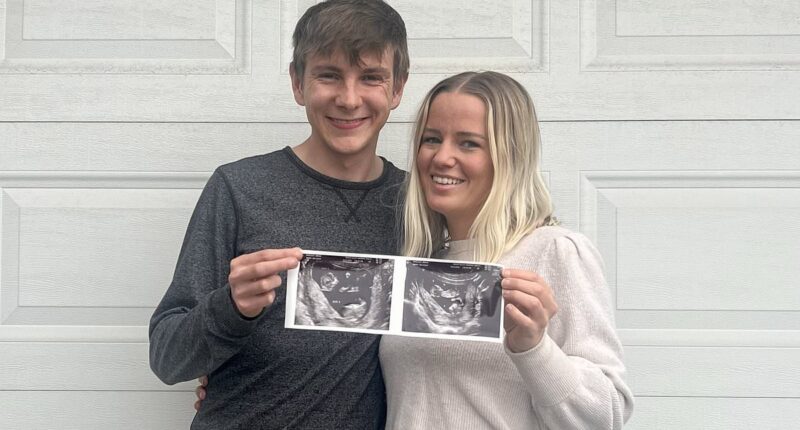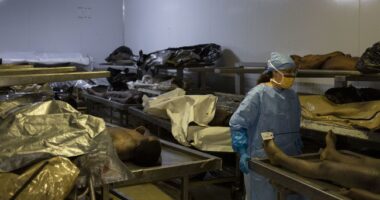Abigail Whitlock experienced a heartbreaking turn of events during her much-anticipated pregnancy when medical professionals diagnosed her with a rare condition. They strongly advised her to consider terminating one of her identical twins.
She was due to have two boys but five months into the pregnancy they were diagnosed with twin-to-twin transfusion syndrome (TTTS).
The condition happens when blood vessels in the placenta aren’t equally connected, causing one of the fetuses to take more of the nutrients.
Subsequently, healthcare providers scheduled Abigail for a precarious laser operation. This procedure involved using a precise beam of radiation to close off abnormal blood vessel connections within the placenta.
Regrettably, unforeseen complications arose during the surgery. Faced with an impossible decision, doctors presented Abigail and her husband Stuart with a devastating ultimatum: either sacrifice one twin to ensure the survival of the other or face the grim possibility of losing both babies.
The medical team strongly recommended that the smaller boy’s umbilical cord was clamped to allow the other twin a greater chance of survival.
But the couple, aged 27 and 28, refused to let one of their twins go and they chose to ‘defer on that decision for a few days.’
By chance – which Abigail chalks up to the ‘faith of friends and family, and the mercy of God’ – at the next check-up, the ailing twin’s condition had miraculously improved and Abigail said they were ‘shocked, overwhelmed and ultimately overjoyed with the good news.’

When Abigail Whitlock and her husband, Stuart, found out they were expecting twins , they were overwhelmed with joy. But sadly, that was only short-lived
The boys – Harvey and Bellamy – are now thriving and healthy at 15 months old.
Explaining the harrowing ordeal, Abigail told DailyMail.com: ‘It was the most emotionally taxing experience we’ve ever had. I would cry all the time and just envision the worst possible outcome.
‘Both myself and Stuart were in complete doubt of what the future held and we had lost all hope at one point.’
Their pregnancy had gone without a hitch, and they fell pregnant within days of starting to try.
It was five months into their pregnancy that they realized something was wrong.
At their 20-week screening scan, the so-called ‘anomaly scan’, the sonographer expressed difficulty getting the images, as there was too much amniotic fluid.
Due to this, they were referred to a specialist, who also found trouble due to the large amount of fluid surrounding the twins.
A few days later, Abigail was diagnosed with TTTS.
TTTS – which impacts around 4,500 babies in the US each year – is a potentially fatal condition that can occur in identical pregnancies when twins share a placenta.
Abnormal blood vessel connections form in the placenta and prevent blood from flowing evenly between the babies.
One twin then becomes dehydrated, which affects its growth. The other develops high blood pressure and produces too much urine.
This leads to an enlarged bladder and excessive amounts of amniotic fluid, which can put a strain on the twin’s heart, leading to heart failure. Without treatment, TTTS can be fatal for both twins.
There’s just a 50/50 chance of both twins surviving.

Abigail was told that her tots had developed twin-to-twin transfusion syndrome (TTTS) while in the womb – and they were showing late signs of organ failure

TTTS – which impacts around 4,500 babies in the US each year – is a potentially fatal condition that can occur in identical pregnancies when twins share a placenta
Recalling how she felt at the time of the diagnosis, Abigail recalled: ‘I wanted to hear their little cries after entering the world – not say goodbye before they had even got here.’
The couple were told that their case was ‘dire and critical’ and they were referred to a specialized hospital in Seattle to have the necessary laser surgery, called fetoscopic laser photocoagulation (FLP).
A small laser was inserted into Abigail’s uterus to cauterize the blood vessels on the placenta, which was connecting the twins.
FLP, though crucial for fetal survival, is not without risk.
FLP for TTTS has has a survival rate of more than 90 percent for at least one twin and 50-70 percent for both twins.
However, there is still an 11 to 14 percent risk of long-term neurodevelopment impairment.
Other complications can include fetal loss, premature delivery and accidental injury to tissue or organs near the operative field.
The surgery was initially a success and around 12 hours later Abigail said doctors told her and Stuart that the twins were showing all of the right signs and things were looking positive.
However, when the couple returned home they suffered ‘another devastating blow’.
They were told the smaller of the twins, Bellamy, had sadly developed hydrops fetalis, a buildup of fluid in his body, resulting in severe swelling and organ failure.
It was likely that he wouldn’t survive much longer.
To allow the other twin, Harvey, a greater chance of living, the doctors recommended for the umbilical cord was clamped, which they denied.
She said: ‘The doctors recommended it though because it was apparent to them that he was going to imminently pass away and clamping his cord would cause him to pass away immediately.
‘And allow Harvey a greater chance at survival. We chose to defer on that decision for a few days.’
But then, a miracle happened.
She said: ‘At the next checkup, we learned that Bellamy had miraculously recovered.
‘We were shocked, overwhelmed and ultimately overjoyed with the good news.

Looking back on the harrowing ordeal, Abigail said: ‘It was the most emotionally taxing experience we’ve ever had. ‘I would cry all the time and just envision the worst possible outcome’

In August 2023, at only 34 weeks, the decision to deliver the twins via c-section was made

Thanks to intervention and dedicated care in the NICU ward, the twins’ strength grew day by day. Today, they are completely healthy
‘All of the fluid had disappeared and he was on track to be here with us once again.’
In August 2023, at 34 weeks, the decision to deliver the twins via c-section was made.
Weighing only 4lbs, Harvey and Bellamy entered the world.
Thanks to intervention and dedicated care in the NICU ward, the twins’ strength grew day by day. Today, they are completely healthy with no issues, despite their troubling past.
Abigail and Stuart hope to share their story to warn other parents going through a similar situation and to provide a message of hope. Especially as the situation could’ve been very different.
Abigail talks openly about her birthing journey on her TikTok channel @twinmomtales, where she has more than 150,000 followers.
The content creator added: ‘It’s been overwhelming and disparaging.
‘My husband and I could barely function or complete the tasks of our everyday life because we were so heavily weighed down by the fact that either one – or both – of our twins that we were so in love with could pass away at any moment, and there was nothing we could do about it.
‘Even for months after the twins were born, we would hold them and cry, and think of how we almost lost them.
‘We credit the miracle of the birth of our twins to the expertise of the medical experts we saw, the faith of our friends and family, and the mercy of god.
‘I know that not all pregnancy stories have a happy ending like ours.
‘For all of the mums out there who struggle with pregnancy or who have lost a child, I would say that miracles do happen.
‘I can also say that the joy that we feel now from having our twins in our lives greatly outweighs the sorrow we felt when we didn’t know if we would ever get to meet them. Don’t lose hope.’

















